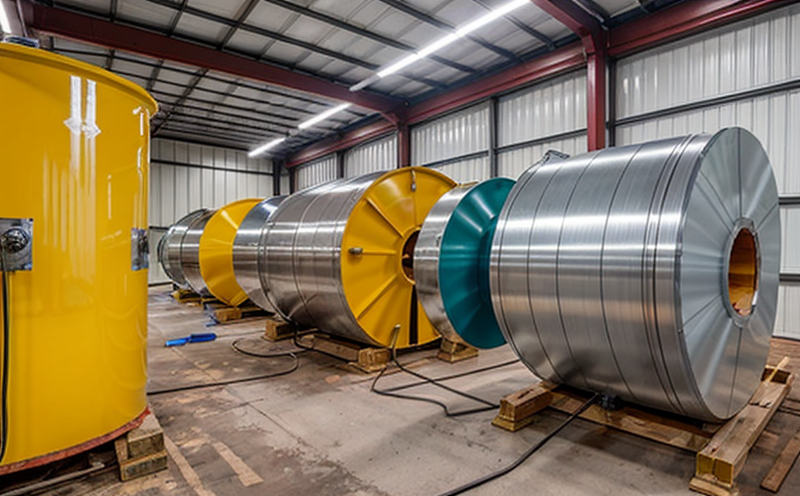ISO 8503 Surface Roughness Testing for Blast-Cleaned Steel
The ISO 8503-1:2007 standard provides a universal approach to characterize the surface roughness of blast-cleaned steel. This test is critical in ensuring that coatings applied to metal surfaces have optimal adhesion, corrosion resistance, and longevity.
Blast cleaning is widely used for removing rust, paint, or other contaminants from metal surfaces before applying protective coatings such as paints, primers, or anti-corrosion treatments. The quality of blast cleaning significantly affects the performance and durability of subsequent coatings. Therefore, ensuring that the surface roughness meets specific criteria is essential.
ISO 8503-1 defines three classes for blast-cleaned steel surfaces: Sa1 (free from loose material), Sa2 (sufficiently clean to remove all visible contamination by means of manual or power tools), and Sa2.5 (sufficiently clean to remove all visible contaminants using sand-blasting, shot-blasting, or similar methods). The Sa2.5 class is the most commonly used for high-performance coatings.
The ISO 8503-1 standard specifies that the surface roughness should be measured at least in two perpendicular directions and over a minimum area of 10 cm². This ensures that the sample's entire blast-cleaned surface receives thorough analysis, providing reliable data on its roughness.
To perform this test, specialized equipment such as a portable profilometer or a non-contact optical profiler is used. The device measures the peak-to-valley distance of the surface irregularities. Typically, these instruments can provide readings in micrometers (µm) and are capable of achieving high precision.
Specimen preparation involves ensuring that the steel surface is clean and dry before measurement. Any remaining contaminants or moisture could affect the accuracy of the test results. After cleaning, the surface should be allowed to dry naturally or with controlled drying methods to prevent any interference.
The testing procedure requires the operator to select a representative area on the steel surface where roughness measurements will be taken. The chosen area must be large enough to ensure that it encompasses all variations in roughness across the blast-cleaned surface. Then, the profilometer is used to scan the selected area, capturing detailed topographical data.
The results of ISO 8503-1 testing are typically expressed in micrometers (µm) and categorized into one of three classes: Sa1, Sa2, or Sa2.5. These classes define the acceptable surface roughness ranges for different types of coating systems to ensure that they adhere properly.
Understanding these standards is crucial because improper blast cleaning can lead to poor adhesion between the substrate and the coating, resulting in premature failure of the protective layer. On the other hand, achieving the correct Sa2.5 class ensures optimal performance and longevity of the applied coatings.
The importance of this test cannot be overstated, especially in industries like marine and offshore where exposure to harsh environments increases the risk of corrosion. By adhering strictly to ISO 8503-1 standards during the blast cleaning process, manufacturers can enhance the durability and effectiveness of protective coatings used in these sectors.
In summary, ISO 8503-1:2007 provides a standardized method for quantifying surface roughness on blast-cleaned steel surfaces. This testing procedure is essential to ensure that applied coatings achieve optimal adhesion, thereby enhancing the overall performance and longevity of the protective layer. Properly executed, this test helps prevent premature coating failure in critical applications such as marine structures.
Benefits
Ensures adherence of coatings to blast-cleaned steel surfaces.
Achieves optimal corrosion resistance and longevity of protective layers.
Meets industry standards and regulatory requirements for quality control.
Improves the performance of anti-corrosion treatments in harsh environments.
Reduces maintenance costs by preventing premature coating failure.
Enhances safety and reliability of structures exposed to marine and offshore conditions.
Industry Applications
Marine and Offshore Structures: Ensures that coatings applied to ships, oil rigs, and platforms adhere properly, enhancing their corrosion resistance.
Offshore Wind Turbines: Protects turbine blades from marine environments, extending operational life and reducing maintenance costs.
Aerospace: Guarantees the integrity of protective coatings used in aircraft manufacturing to ensure long-term durability.
Oil & Gas Pipelines: Ensures that coating systems on pipelines provide effective protection against corrosion under ground conditions.
Tankers and Cargo Ships: Improves the longevity and performance of coatings applied to hulls, reducing maintenance requirements.
Why Choose This Test
Selecting ISO 8503-1 for surface roughness testing offers several advantages:
Standardization: It provides a consistent method across different facilities, ensuring uniform results.
Regulatory Compliance: Adherence to this standard ensures compliance with international regulations and industry best practices.
Precision Measurement: The use of advanced instrumentation guarantees accurate measurements that influence the quality of subsequent coatings.
Enhanced Durability: By ensuring proper surface preparation, this test enhances the overall durability and effectiveness of protective coatings.
The ISO 8503-1 standard is widely recognized in sectors that rely heavily on blast cleaning for preparing metal surfaces before applying protective coatings. Its reliability and accuracy make it an indispensable tool for quality assurance professionals, compliance officers, and R&D engineers working in these industries.





